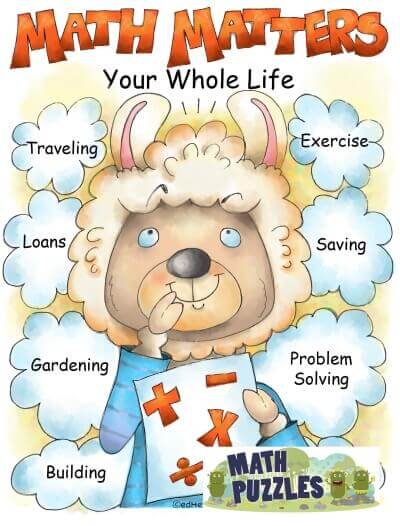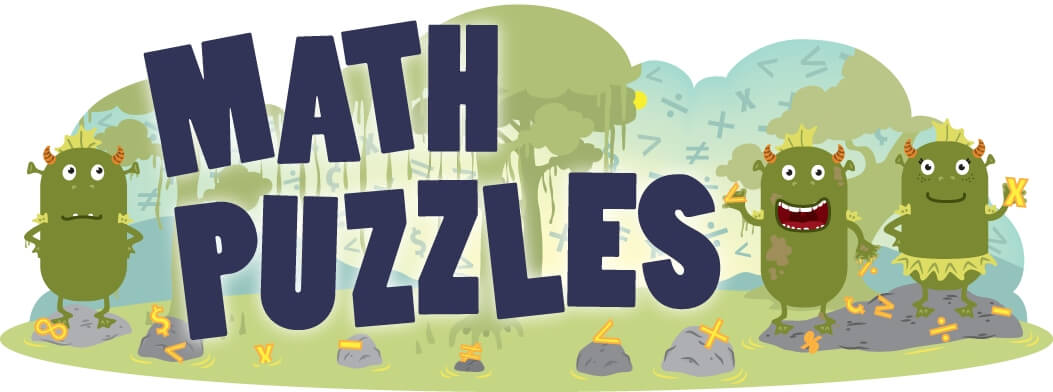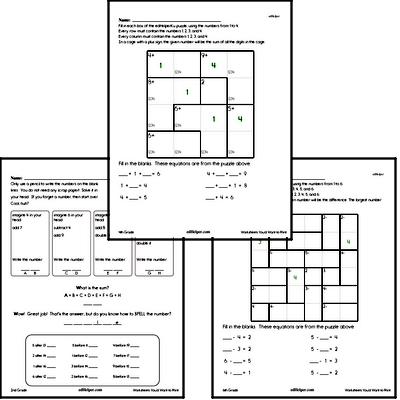4 Ways to Strengthen Students' Primary Math Skills for Long-Term Use (Free Math Puzzle Printables)
By: edHelper Staff
Updated: Feb 24, 2020

It's no doubt that math gets a bad rep in classrooms. Heck, even adults bond over horror stories of math class back in eighth grade.
This, though, is where superheroes (i.e., you!) come in to lessen the stigma of math. Right from the get-go, you'll help students develop long-term skills to ensure they succeed in all future math classes.
There may not be a clear-cut moment in time when math suddenly gets scary for some students, but here are four ways to make mathematics less of a beast to tackle in the long term.

1. Presenting Unconventional Math Exercises
We know that some subjects by nature can leave students less willing to stay focused and engaged in class settings, and math can be one of those subjects.
However, this can be avoided by introducing creative worksheets like math puzzle worksheets. Students will be too busy following the fun instructions to realize they are building up their math skills!
The National Council of Teachers of Mathematics (NCTM) is an international mathematics education organization that offers learning methods and resources for teachers. The NCTM released a report on the top eight ways teachers can effectively teach mathematics, and one of them is utilizing visual or tangible representations.
In fact, the professionals at NCTM aren't the only ones who believe adding visuals will help students to effectively understand mathematical concepts. Even the late Maryam Mirzakhani, a recipient of the Medal for Outstanding Discoveries in Mathematics and world-renowned mathematician, treated math as art.
The New York Times wrote a tribute to her, which included some of her past interviews. Explaining her thinking process, she had said, "You don't want to write down all the details. The process of drawing something helps you somehow to stay connected." Maryam was known for sitting on the ground and drawing out shapes and doodles for hours on end to better understand and connect more complex theories.

2. Make 'Em Struggle . . .
Interactive STEM is a five-year initiative supported by the National Science Foundation and bringing together students and teachers through research. Marian Pasquale, an Interactive STEM senior research scientist, mentions in an article that society needs to make great strides to reduce the stigma attached not to math, but to the perceived struggle in math.
She provides an amazing analogy, asking why students might spend countless hours solving puzzles, but the same level of 'struggle' is off-putting for many students in math classrooms. Marian argues that with puzzles, students "feel as if they can make headway," and in classrooms, research has shown that struggling is viewed as a problem and is cast in a negative light.
Marian explains, "Often, individual performance is prized over group problem solving; having the right answer over [understanding], and being the first to finish over-explaining and communicating."
It may be beneficial to ask yourself, "Am I praising my students on solely finding the right answer, or on their ability to ask questions, talk to peers, and embrace the 'struggle?' "
3. Encourage Open Discussion
How to work in groups is a valuable skill to teach students so that they can understand concepts better, especially in primary school. The importance of not falling behind, particularly in mathematics, is a universal truth that all teachers, students, and professionals will agree on. By teaching your students to work together in teams to understand a problem, especially if they don't understand it initially, they will be better equipped for future math classes and even careers.
For instance, younger grade classrooms can be turned into open discussions to determine where students are with a concept, and upper grades can test their knowledge with mock math tournaments.
You can use sample questions, like the ones used in the Math League worksheets from the grade four curriculum to grade six. Your students can be divided into teams. You'll then put up a math problem on the board, and they will have to deliberate and write out the problem on paper or the whiteboards provided.
Group work in any elementary grade has many proven benefits.
First, encouraging students to talk out loud and vocalize their thoughts will help them to hear each other's train of thoughts, and either their peers or you will be better able to catch any misunderstandings about a particular lesson. Oxford Learning explains, "A true test in knowing if a student understands a concept or not is if he or she is able to explain it to someone else."
Group studying has also been found to help students motivate each other. If students, especially younger ones, see their peers working diligently on a problem, they will be more inclined to join in and less inclined to procrastinate or get distracted. Oxford Learning adds, "Many students derive energy from being around other people and look forward to learning and discussing material with classmates." It makes sense why students are more inclined to "see what's up" and join in when a small group is huddled or busy working on a group activity.
Finally, teaching students at a young age that it is all right to ask for help creates a strong foundation for their future selves to excel in classes like mathematics. They will feel less isolated in not understanding a problem.
In university/college-level courses, many first-year students struggle with the jump from high school to upper-level education. Students who have been taught that it's all right to ask for help will benefit greatly over students who internalize their frustrations around not understanding a lesson in math.
4. Use Personalized Storytelling
Ever notice how our ears pick up on a conversation within a split-second if someone mentions our name? Suddenly, the same conversation that we've zoned out is fully within the forefront of our minds.
If students are able to relate to the characters in math problems which may have the same gender, race, name, or age as them, they will be more inclined to listen - and with excitement.
On the same note, making the classroom more inclusive of every student will help boost self-confidence and show students that math is not just a class to strive to do better in; it's also a community.
Ansie Harding, a mathematics education researcher, wrote a paper in 2018 outlining ways in which storytelling can be a part of mathematics classrooms.
Harding explains that one way to use storytelling is "using a story as a 'by the way,' weaving it into the teaching as a short anecdote or an amusing snippet." Students are more likely to remember the fun and exciting stories as part of their learning. However, Harding warns that the aim is to keep the math concepts as the primary driver and use the snippets merely to gain students' attention.
Another way Harding encourages teachers to use storytelling in math classrooms is in the form of "commercial breaks," "somewhere in the middle of the lesson, [and] between topics." Harding explains that students' attention spans are limited, and the stories can act as a form of short entertainment.
Over time, we can see how mathematics can be transformed into a subject that is not only fun but also challenges students' creativity and independent thinking.














